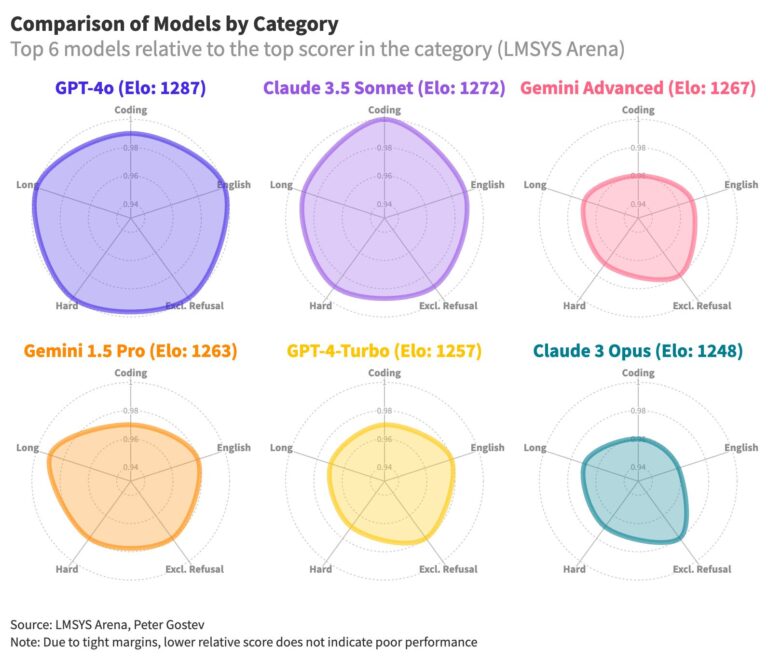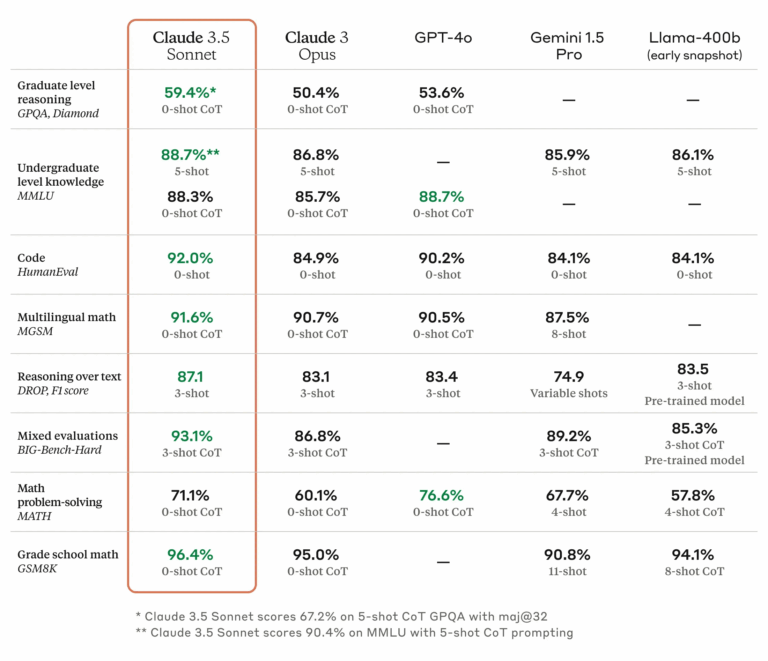Claude 3.5 Sonnet emerges as the superior choice for coding and creative writing tasks, delivering nearly bug-free code on first attempts and more natural, human-like text generation. GPT-4o maintains advantages in mathematical reasoning (76.6% vs 71.1% on MATH benchmark), speed (24% faster response times), and multimodal capabilities including web search access. For developers and content creators, Claude offers exceptional value, while GPT-4o serves users requiring fast responses and comprehensive tooling.
Both models represent cutting-edge AI technology, but your choice depends on primary use cases: Claude for sophisticated text and code work, GPT-4o for versatile, rapid-fire tasks across multiple domains.
Introduction
The artificial intelligence landscape experienced a dramatic shift in 2024 when Anthropic released Claude 3.5 Sonnet and OpenAI unveiled GPT-4o. These flagship models now dominate conversations among developers, content creators, and AI enthusiasts seeking the most capable language model for their workflows.
Claude 3.5 Sonnet sets new industry standards in graduate-level reasoning, undergraduate-level knowledge, and coding proficiency, while GPT-4o is OpenAI’s high intelligence model offering versatile processing of text, audio, image, and video inputs. Understanding their distinct strengths helps users make informed decisions about which AI assistant deserves a permanent spot in their toolkit.
Performance Benchmarks: Where Each Model Excels
Graduate-Level Reasoning Capabilities
Claude 3.5 Sonnet leads with a 59.4% score on 0-shot CoT GPQA, while GPT-4o has a 53.6% score on zero-shot CoT. This benchmark evaluates complex reasoning abilities at graduate academic levels, where Claude demonstrates superior analytical thinking and problem-solving approaches.
The reasoning advantage extends beyond raw scores. Claude consistently produces more thoughtful responses that consider multiple perspectives before reaching conclusions, making it particularly valuable for research, analysis, and strategic planning tasks.
Mathematical Problem-Solving Performance
Mathematics reveals GPT-4o’s computational strengths. GPT-4o leads with a 76.6% score on 0-shot CoT, while Claude 3.5 Sonnet has 71.1% score on zero-shot CoT on the MATH benchmark. This gap becomes significant for users requiring precise numerical calculations, statistical analysis, or advanced mathematical modeling.
However, Claude 3.5 Sonnet achieves the highest Multilingual Math scores at 91.6%, with Claude 3 Opus in second at 90.7%, demonstrating superior performance when mathematical problems involve multiple languages or cultural contexts.
Speed and Responsiveness Analysis
GPT-4o’s average latency is 24% faster than Claude-3.5-Sonnet (7.5226s vs 9.3055s). Speed differences become pronounced during extended conversations or when processing multiple requests simultaneously.
GPT-4o’s average time to first token(TTFT) is 2x faster than Claude-3.5-Sonnet (0.5623s vs 1.2341s), creating noticeably snappier interactions. For applications requiring real-time responses or handling high-volume queries, GPT-4o’s speed advantage proves decisive.
Coding Excellence: A Developer’s Perspective
Code Quality and Accuracy
Professional developers consistently report Claude’s superior coding capabilities. In an internal agentic coding evaluation, Claude 3.5 Sonnet solved 64% of problems, outperforming Claude 3 Opus which solved 38%. Real-world testing confirms these benchmarks translate to practical advantages.
Experienced programmers describe Claude as producing “nearly bug-free code on the first try,” while GPT-4o often requires multiple iterations to achieve similar results. Claude’s code exhibits better structure, more thoughtful variable naming, and cleaner implementation patterns that reflect genuine programming expertise.
Complex Programming Tasks
Claude 3.5 Sonnet seems like the definition of artificial general intelligence (assuming we’re not moving the goalpost). Claude is brilliant, lightning fast, can follow instructions, and strives to be factually accurate. This assessment from developers testing both models on complex financial algorithms highlights Claude’s ability to handle sophisticated programming challenges.
When building applications requiring multi-step logic, database integration, or advanced algorithms, Claude demonstrates superior understanding of software architecture principles. It produces code that experienced developers recognize as professionally crafted rather than mechanically generated.

Comparison of models by category. Image credit: Peter Gostev/LMSYS Arena via Linkedin
Development Workflow Integration
Claude’s introduction of Artifacts creates dynamic workspaces where developers can see, edit, and build upon AI-generated code in real-time. This feature transforms Claude from a simple code generator into a collaborative programming partner.
GPT-4o compensates with broader ecosystem integration, offering plugins, web access, and seamless connection to development tools. For teams already invested in OpenAI’s ecosystem, GPT-4o provides smoother workflow integration despite Claude’s superior raw coding abilities.
Text Generation and Creative Writing
Natural Language Quality
Claude produces notably more human-like text that avoids common AI writing patterns. While GPT-4o has improved significantly from previous versions, it still occasionally falls into formulaic structures and overused phrases that immediately identify content as AI-generated.
Professional content creators report Claude’s writing feels more authentic and engaging, requiring less editing to achieve publication-ready quality. This advantage proves crucial for marketing content, blog posts, and communication materials where natural tone matters.
Creative and Analytical Writing
Claude’s Styles feature also makes it easier to jump between different custom writing styles. For example, you could set up an informal writing style for internal memos, a peppier one for social media posts, and a thoughtful one for long-form content. This flexibility allows users to maintain consistent voice across different content types.
Claude excels at producing sophisticated analyses that demonstrate nuanced understanding of complex topics. Its writing exhibits depth and consideration that rivals human experts in many domains, making it particularly valuable for research papers, strategic documents, and thought leadership content.
Data Processing and Classification Tasks
Information Extraction Performance
Real-world testing on legal contract analysis reveals interesting performance patterns. GPT-4o outperformed Claude 3.5 Sonnet on 5 of the 14 fields, maintained similar performance on 7 fields and showed degraded performance on 2 fields when extracting key information from Master Services Agreements.
However, both models achieved only 60-80% accuracy on most fields, indicating that complex data extraction still requires advanced prompting techniques regardless of model choice. The performance gap narrows significantly with proper prompt engineering and few-shot examples.
Classification Accuracy
Customer support ticket classification testing revealed Claude’s precision advantages. Claude 3.5 Sonnet (0.72) does better than GPT-4o (0.65) in overall accuracy, though GPT-4o has the highest precision at 86.21%, indicating it is the best at avoiding false positives.
This distinction matters for business applications where false positives create customer service problems. GPT-4o’s conservative classification approach reduces risky misidentifications, while Claude’s higher overall accuracy catches more edge cases correctly.
Context Understanding and Memory
Document Processing Capabilities
Claude 3.5 Sonnet offers a generous maximum context window of 200k tokens, which is equivalent to approximately 150,000 words or 300 pages. This substantial context window enables comprehensive analysis of lengthy documents, codebases, and research materials without losing crucial information.
Both models demonstrate sophisticated understanding of document structure, but Claude shows superior ability to maintain thematic coherence across long passages. When summarizing research papers or analyzing complex reports, Claude preserves nuanced relationships between ideas more effectively.
Conversational Memory
Claude 3.5 Sonnet outperforms in Reasoning Over Text (87.1%), with Llama-400b in second (83.5%). This benchmark measures ability to understand and reason about textual information, a crucial capability for maintaining coherent extended conversations.
Users report Claude better remembers conversation context and builds upon previous discussion points naturally. This advantage becomes pronounced during lengthy problem-solving sessions or creative collaborative work where maintaining thread consistency matters.
Pricing and Accessibility
Cost Structure Comparison
Claude Pro plan: $18 per month for additional features versus ChatGPT Plus: $20/month for full access. Claude offers slightly lower subscription costs, though the difference rarely influences purchase decisions given the minimal gap.
API pricing: $3 per million tokens for input, $15 per million tokens for output for Claude compared to API pricing: $2.50 per million tokens for input for GPT-4o. For high-volume API users, these differences accumulate significantly over time.
Usage Limitations and Access
Free tier limitations create practical decision points for many users. Claude imposes more restrictive message limits based on content length rather than simple message counts, sometimes limiting users after just 10-15 complex requests.
GPT-4o provides more predictable usage patterns with clearer daily limits, though free users get pushed to the less capable GPT-3.5 model when limits are exceeded. Claude maintains consistent quality even at free tier limits, while GPT-4o creates a more jarring experience transition.
Multimodal and Advanced Features
Image and Media Processing
GPT-4o offers comprehensive multimodal capabilities including image generation through DALL-E integration, audio processing, and video understanding. ChatGPT’s broader feature set and lower API pricing make it perfect for teams and solo users who want to explore the full spectrum of AI capabilities.
Claude provides strong vision capabilities for document analysis, chart interpretation, and image-based reasoning, but lacks image generation features. For users requiring all-in-one AI solutions, GPT-4o’s expanded toolkit provides clear advantages.
Web Access and Real-Time Information
GPT-4o has the advantage of delivering information about recent events, given its ability to search the web for news that’s more recent than its training data. This capability proves essential for users needing current information, market updates, or recent research findings.
Claude also has a more recent knowledge cutoff date than GPT-4o: April 2024 versus October 2023, but lacks web search capabilities. Users requiring current information must supplement Claude with external research tools.
Practical Use Case Recommendations
For Software Development
Choose Claude 3.5 Sonnet when building complex applications, refactoring legacy code, or requiring high-quality initial implementations. Its superior coding abilities reduce debugging time and produce more maintainable code.
Select GPT-4o for rapid prototyping, when integrating with existing OpenAI toolchains, or when you need web access for researching current development practices and frameworks.
For Content Creation and Writing
Claude excels at long-form content, analytical writing, and maintaining consistent voice across different content types. Its natural writing style requires minimal editing for professional publication.
GPT-4o works better for quick content generation, when you need image creation alongside text, or for projects requiring real-time information incorporation.
For Business and Research Applications
Claude provides superior performance for in-depth analysis, strategic planning, and complex reasoning tasks that require nuanced understanding of multiple factors.
GPT-4o serves better for customer-facing applications requiring fast responses, real-time information access, or multimedia content generation.
Final Verdict: Choosing Your AI Partner
The Claude vs GPT-4o decision ultimately depends on your primary use patterns rather than abstract capability comparisons. Claude 3.5 Sonnet represents the pinnacle of thoughtful AI assistance, producing higher-quality outputs that require less human refinement. Its coding excellence and natural writing style make it indispensable for professionals prioritizing output quality over speed.
GPT-4o delivers comprehensive AI capabilities with superior speed, multimodal features, and real-time information access. Its ecosystem integration and versatile toolset appeal to users wanting one platform for diverse AI tasks.
Consider maintaining subscriptions to both models if your work spans multiple domains. Many professionals use Claude for deep work requiring quality and precision, while relying on GPT-4o for quick tasks, research, and multimedia projects.
The AI landscape continues evolving rapidly, but both models have established themselves as essential tools for different aspects of modern knowledge work. Your choice should align with whether you value depth and quality (Claude) or breadth and speed (GPT-4o) for your specific workflow requirements.
- AI in Law Enforcement: Enhancing Digital Evidence Management
- How to prepare data for machine learning and prevent model overfitting?
- Understanding Multimodal AI




